Nanobubbles and nanodrops
Promotion date: September 25.
Promotor: Prof. dr. rer. nat. Detlef Lohse
Assistant promotor: Dr. ir. Jacco Snoeijer
| In this thesis we address the behavior of so-called surface nanobubbles.These nanobubbles behave different from ordinary (macroscopic) bubbles in several ways: (i) The gas-side contact angle of surface nanobubbles is lower than that of regular bubbles (i.e. nanobubbles are flatter). (ii) Nanobubbles can resist high tensile stresses and most importantly: (iii) The lifetime of surface nanobubbles is several orders of magnitude greater than expected. In this thesis we combine numerical techniques (molecular dynamics) and theoretical efforts to explain these properties of surface nanobubbles. |
What techniques were important in your PhD project?
Numeric and simulations techniques were involved here, and, later, a theoretic model was constructed. The special features of nanobubbles are a topic many experts all over the world are working on. It is a kind of ‘smoking gun’ in this field of research, so to say.
In particular the lifetime of nanobubbles is many times greater than one might expect from macroscopic considerations only. This order of magnitude is over ten times. In some conditions these bubbles may even survive over several days, due to different geometric features.
The way these nanobubbles dissolve is different. It was proven experimentally that when nanobubbles dissolve they are not growing smaller, only flatter. This has important implications. In the thesis report we develop a new theoretic model from this observations, working out very nicely indeed. The model rightly predicts the longer lifetime of the nanobubbles as well as some other properties. Furthermore, the model provides insight with which we can really interfere with some properties, most involving the lifetime of the nanobubbles. This can be of use in practical applications.
Were there some highlights happening in the PhD process?
The discovery of these dissolving features and the simulation techniques I developed, I perceive as nice results. So, here I was very lucky. Collaboration started from these, for example with Jacco Snoeijer. The simulation techniques used in the nanobubble project proved to be very useful in the line of research concerning wetting of soft surfaces.
Several publications came forth from the various research topics, like in Physical Review Letters, ChemPhysChem, Physical Review E, the American Journal of Physics, Soft Matter, and Physics of Fluids. Two more papers are submitted right now.
In what way did you develop as a scientist and researcher in these last four years?
Working on simulations and going deep into literature, I developed a more profound feeling for the phenomena involved. Only after doing so, I succeeded in constructing a theoretic model which was surprisingly straightforward, on hindsight. In the middle of the process though, one cannot tell what results will come out of it.
What are your future plans?
I’m applying for a post-doc position abroad, as it will be beneficial for my future academic career. By doing so, I am now choosing actively for this kind of career. Starting a PhD project was a much more less consciously taken decision, in my view. The PhD appointment was in line with earlier work in my master work. I like the freedom of working in an academic environment, and I was lucky to work on various subjects. Now I am planning to pursue my career in academics.
Did you feel part of the Mesa+ community?
On a daily basis I was not very much involved in the Mesa+ type of research. However, several experiments were performed in collaboration with colleagues, both scientists and technicians. For example lithography techniques were of interest for me. Also, I enjoyed the Mesa+ Days in which one can get acquainted with colleagues and research topics, even starting some collaboration out of these contacts.

